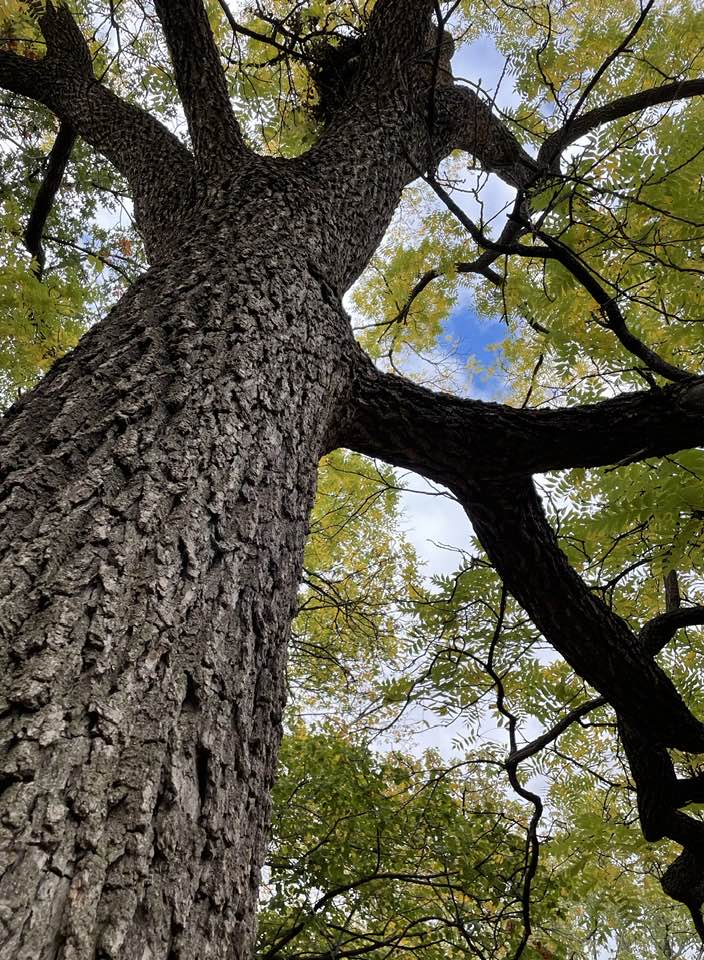OCTOBER 7, 2022 – Today while hiking through our local Garden of Eden, I read some of the tags that the park service had nailed to a number of big, beautiful trees. Each tag identified the species, its characteristics, and in almost every case, what the tree was “good for . . .” These descriptions of commercial value were jarring. They harkened back to an era before the 20th century, though the tags themselves were of recent production, as revealed by QR codes and a web address. Typical was the description on a quercus macrocarpa (bur oak): “Its wood is used for cabinets, ship building, fence posts, fuel and cooperage [wooden barrel-making].”
I’ve surely consumed more wood products than most people, and perhaps this unfortunate fact explains why in penance I’m also very much a “tree-hugger.” There was a day when I didn’t think twice about driving to Home Depot, selecting lumber, and carting it home or to the Red Cabin to incorporate into one project or another. With awareness of climate change, however, and the remedial role played by trees, I’ve become far more circumspect about buying lumber . . . and burning firewood.
Nothing pains me more than to read about destruction of the rain forests of South America and Southeast Asia . . . or to hear about the wanton felling of the enormous bur oaks in the yard of our family’s first home in Anoka, Minnesota.
Today, those tags pinned on arboreal royalty reminded me of a disturbing passage in Crazy Horse and Custer by Stephen E. Ambrose. The book is a brilliant comparative study not only of the title characters but of their respective cultures. I’d always perceived Ambrose as chauvinistic toward (white) American power and prowess, so his acerbic criticism of our “rugged individualism” struck me as out of character for him.
He pulled no punches when describing how white American settlers destroyed the Ohio Valley. Across five pages of unrelenting facts about early Americans’ assault on the environment, one paragraph jumped out:
The magnificent forests of the Ohio Valley, unsurpassed anywhere, were in the eyes of Ohioans nothing more than obstacles to progress. Standing trees were an affront to Americans, because they were worse than useless—they took up sunlight and soil nutrients that could better be used by corn. Although everyone used wood as a source of heat or as building material, few thought of the forest in productive terms, since there was more wood than could ever possibly be used or so the settlers believed. Ohioans were united in their desire, nay passion, to destroy the forest and much of their working time went into the task. (p. 26)
He proceeded to describe in almost apocalyptic terms, how oak, beech, and walnut trees standing since the time of Columbus were strangulated (girdled), then cremated in enormous pyres. “This assault on nature,” Ambrose wrote, “than which few more frightful spectacles could be imagined, owed much to the sheer need but something also to a compelling desire to destroy conspicuous specimens of fauna and flora of the wilderness.” (p. 27)
Like it or not, acknowledge it or not, our current culture of #MeNow—and its self-extinction potentiality—is deeply rooted in our past.
Next time you see a tree, give it a hug of reassurance. Better yet, next chance you get to plant a tree, seize the imperative.
(Remember to subscribe to this blog and receive notifications of new posts by email.)
© 2022 by Eric Nilsson
